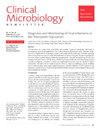非结核分枝杆菌的实验室诊断-更新-第3部分*:分子诊断、环境检测和应通报的条件
Q3 Medicine
引用次数: 0
摘要
与20-30年前相比,现在在实验室中更经常遇到非结核分枝杆菌(NTM)。为了准确检测和鉴定越来越多的新NTM物种,新的媒介和分子分析方法已经被引入。此外,对大环内酯类和氨基糖苷类耐药基因进行了鉴定。NTM经常与医院暴发有关,而水源往往是罪魁祸首。这份由三部分组成的出版物的作者旨在提供目前NTM临床诊断的最新情况,以及关于检测NTM水或环境样本的信息,因为这通常是临床实验室的要求。对于NTM疾病的发展,有三个因素/力量在起作用:宿主特征、NTM和环境。本文章由计算机程序翻译,如有差异,请以英文原文为准。
Laboratory diagnosis of nontuberculous mycobacteria – an update – Part 3*: Molecular diagnostics, environmental testing, and notifiable conditions
The nontuberculous mycobacteria (NTM) are now more frequently encountered in the laboratory compared to 20-30 years ago. New media and molecular assays have been introduced for the accurate detection and identification of an increased number of new NTM species. Furthermore, antimicrobial drug resistance genes have been characterized for the detection of macrolide and aminoglycoside resistance. NTM are often involved in nosocomial outbreaks where water sources are often the culprit. The authors of this 3-part publication aimed to provide an update on current clinical diagnostics for NTM as well as information about testing water or environmental samples for NTM, since this is often requested of the clinical laboratory. For an NTM disease to develop, a trifecta of elements/forces are in play: host characteristics, the NTM, and the environment.
求助全文
通过发布文献求助,成功后即可免费获取论文全文。
去求助
来源期刊

Clinical Microbiology Newsletter
Medicine-Infectious Diseases
CiteScore
2.20
自引率
0.00%
发文量
35
审稿时长
53 days
期刊介绍:
Highly respected for its ability to keep pace with advances in this fast moving field, Clinical Microbiology Newsletter has quickly become a “benchmark” for anyone in the lab. Twice a month the newsletter reports on changes that affect your work, ranging from articles on new diagnostic techniques, to surveys of how readers handle blood cultures, to editorials questioning common procedures and suggesting new ones.
 求助内容:
求助内容: 应助结果提醒方式:
应助结果提醒方式:


